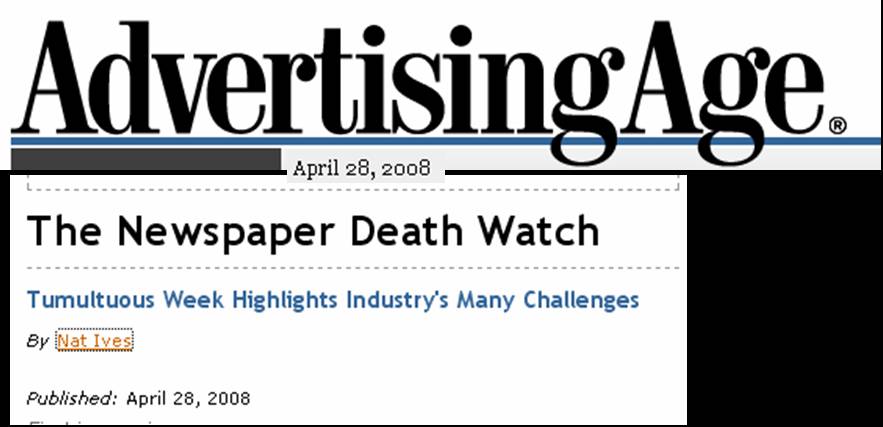 The oddmakers are still placing their bets on Rupert Murdoch to emerge from the Big Apple newspaper scrum clutching Newsday, but he apparently won’t get it without a fight. Newsday itself reports that Cablevision is ready to hike its bid above $600 million, meaning that Messrs. Murdoch and Mortimer Zuckerman will probably have to raise their bids as well. Cablevision’s controlling Dolan family apparently feel that Long Island is home turf, and may even join in a joint offer with New York Observer owner Jared Kushner to keep Murdoch’s hands off the paper. Meanwhile, Murdoch has hired former U.S. Senator Alfonse D’Amato to grease the skids with local elected officials, who still have the power to nix the deal.
The oddmakers are still placing their bets on Rupert Murdoch to emerge from the Big Apple newspaper scrum clutching Newsday, but he apparently won’t get it without a fight. Newsday itself reports that Cablevision is ready to hike its bid above $600 million, meaning that Messrs. Murdoch and Mortimer Zuckerman will probably have to raise their bids as well. Cablevision’s controlling Dolan family apparently feel that Long Island is home turf, and may even join in a joint offer with New York Observer owner Jared Kushner to keep Murdoch’s hands off the paper. Meanwhile, Murdoch has hired former U.S. Senator Alfonse D’Amato to grease the skids with local elected officials, who still have the power to nix the deal.
Fortune’s Devin Leonard has an insightful analysis of the financial machinations behind the Muroch-Zuckerman dogfight. He says Murdoch’s proposal to Tribune Co. owner Sam Zell isn’t an outright buy but a joint venture between Tribune and News Corp. Such a deal would save the famously tax-averse Zell a lot of money in capital gains taxes while shoring up the money-losing New York Post. Of course, Murdoch would still have to get the deal past the FCC, but his track record there has been pretty good. Meanwhile, Zuckerman probably sees a Newsday-Post combination as a death knell for his Daily News, a fact that may force him to raise his offer.
Over at The Wall Street Journal, the special committee to oversee editorial independence issued a protest against the way former WJS managing editor Marcus Brauchli’s resignation was handled last week. The committee says it was informed after the fact in a manner that was inconsistent with the letter and spirit of its agreement with Murdoch. It plans to play an active and vigorous role in hiring a successor, said a statement by the five-member committee, whose formal authority is unclear. Chairman Thomas Bray hastened to note that he has no intention of stepping down from the committee, which isn’t surprising, considering that members are paid $100,000 a year for their work.
Retired LA Times veteran Ken Reich shares his plain-talk view of the difference between Tribune and News Corp., casting his vote for Murdoch. “He invests in his newspapers. He builds them up, rather than tears them down,†Reich writes. He then goes on a tirade against the situation at the LA Times, particularly the “squalid duet [sic]†of publisher David Hiller and editor Russ Stanton. The editor “likes to write memos, and each one is dumber than the one before. He is a lackey to Hiller,†says Reich, who is probably not seeking freelance work from his former employer. Thanks to the LA Times Pressmens Club blog for the link. But guys, you’ve got some serious spyware issues.
Pearlstein Cautions Against Too Much Hyper-locality
Pulitzer Prize-winning business columnist Steve Pearlstein of the Washington Post advises putting the brakes on the rush to hyper-local journalism. In a speech to the Society of American Business Editors and Writers annual conference, he said that readers value business coverage and that news of markets and investments shouldn’t be overshadowed by what’s happening down the street.
Pearstein’s message was a little too late for the St. Petersburg Times, which is continuing an industry trend by merging its stand-alone business section into the rest of the paper. There’ll be a full page of business news, but stocks are going away, to be replaced by summary market data.
A Peek at the Future
Editors Weblog has two interesting short items today:
 The Norwegian press is integrating computer programmers into its news staff because editors believe that databases and online mashups are becoming a critical part of the reporting process. Norway’s public broadcasting flagship’s latest project is Politikerdatabasen, “a database that currently contains information on all members of parliament in Norway and will expand to include information on the country’s 11,000 local politicians in May.†The editor in charge says that all reporters should learn programming skills, to go along with the photography and video skills they’re now having to adopt.
The Norwegian press is integrating computer programmers into its news staff because editors believe that databases and online mashups are becoming a critical part of the reporting process. Norway’s public broadcasting flagship’s latest project is Politikerdatabasen, “a database that currently contains information on all members of parliament in Norway and will expand to include information on the country’s 11,000 local politicians in May.†The editor in charge says that all reporters should learn programming skills, to go along with the photography and video skills they’re now having to adopt.- The site also tells how the U.K.’s Evening Leader is using Twitter to cover soccer matches. “The tweets, texted every few minutes by deputy editor Martin Wright, appeared both on a widget on the Leader website and on the paper’s Wrexham Twitter account.â€




